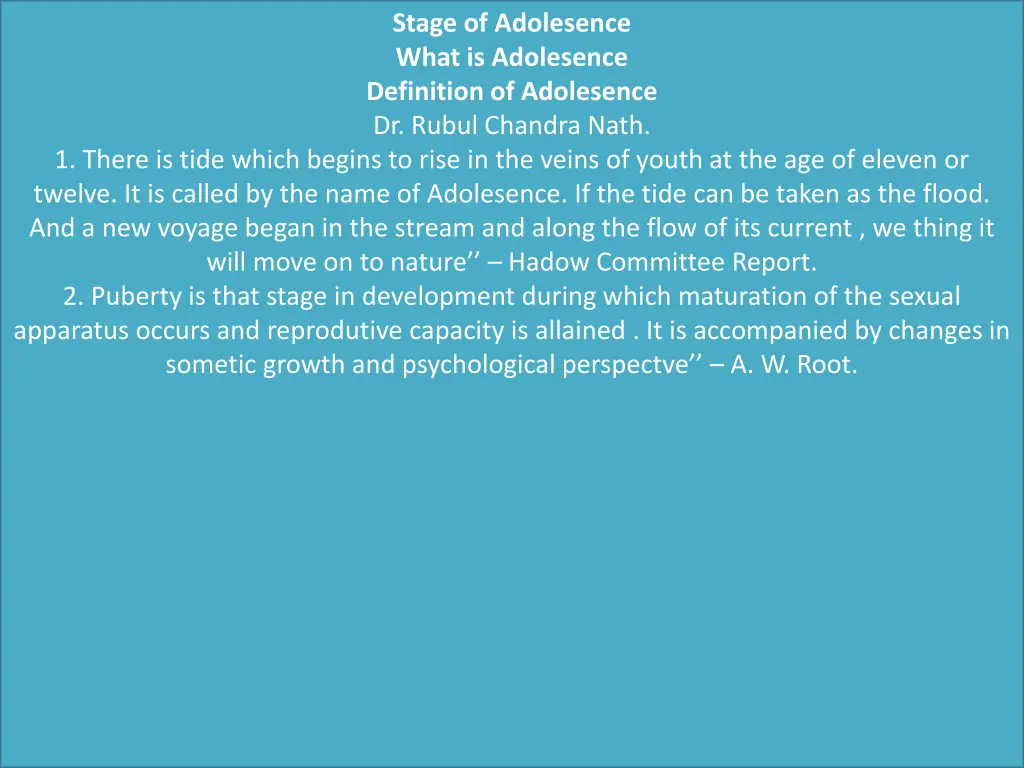
Understanding Adolescence: Physical, Mental, and Emotional Development
Adolescence is a crucial stage marked by physical changes, mental development, and emotional challenges. It involves puberty, growth spurts, cognitive changes, and social adjustments. This phase requires support and guidance to navigate successfully.
Download Presentation

Please find below an Image/Link to download the presentation.
The content on the website is provided AS IS for your information and personal use only. It may not be sold, licensed, or shared on other websites without obtaining consent from the author. If you encounter any issues during the download, it is possible that the publisher has removed the file from their server.
You are allowed to download the files provided on this website for personal or commercial use, subject to the condition that they are used lawfully. All files are the property of their respective owners.
The content on the website is provided AS IS for your information and personal use only. It may not be sold, licensed, or shared on other websites without obtaining consent from the author.
E N D
Presentation Transcript
Stage of Adolesence What is Adolesence Definition of Adolesence Dr. Rubul Chandra Nath. 1. There is tide which begins to rise in the veins of youth at the age of eleven or twelve. It is called by the name of Adolesence. If the tide can be taken as the flood. And a new voyage began in the stream and along the flow of its current , we thing it will move on to nature Hadow Committee Report. 2. Puberty is that stage in development during which maturation of the sexual apparatus occurs and reprodutive capacity is allained . It is accompanied by changes in sometic growth and psychological perspectve A. W. Root.
PHYSICAL CHANGES DURING PUBERTY (i) Changes height and weight. (ii) Body Proportion. (iii) Sex changes. (iv) Changes in External Organs of the body. (v) Changes in the internal Organs. PHYSICAL DEVELOPMENT. (i) External Changes. (ii) Internal Changes. (iii) Motor Ability. MENTAL DEVELOPMENT. (i) Memory. (ii) Attention. (iii) Aptitude. (iv) Learning Ability. (v) Problems solving Ability. (vi) Power of Abstract thinking.
(vii) Creative Ability. (viii) Aesthetic and Pragmatic. (ix) Ability of Deccision making. (x) Philosophy of life. EMOTIONAL DEVELOPMENT AND CHARACTERITICS (i) Too much of emotion. (ii) Violent of Situation. (iii) Complexity of emotion. (iv) Love of loneliness. (v) Abstract emotion. (vi) Fellow feeling. (vii) Impathy. (viii) Sense of self respect. (xi) Sexual excitiment. CAUSES OF ADOLESCENTE EMOTIONS (i) Problems of adjusment. ii) Vocational problems. (iii) Problem of moral values.
(iv) Cultural difference. (v) Failer to get social recognition. (vi) Emotional insecurity. (vii) School Failer. (viii) Sex curiosity. (ix) Sense of in adequeacy. (x) Parental control. SOCIAL DEVELOPMENT AND CHARACTERSTICS (i) Social Consciousness. (ii) Assoiation with the Aduct. (iii) Improve Relationship with the apposite sex. (iv) Selection of intimate friend. (v) Peer Group influence. (vi) Unsocial and delimquent. (vii) Sense of patriotion. (viii) Ability of Leadership. (ix) Sense of Active politics. (x) Self regarding sentiment.
PROBLEMS OF ADOLESCENCE (i) Problems of adjustment. (ii) Sex problems. (iii) Emotional Problems. (iv) Educational problems. (v) Social problems. (vi) Problems of moral values. (vii) Problems of Leisure. (viii) Problems of delimquency. SOLUTION OF THE PROBLEMS (i) Diversification courses. (ii) Vocationalisations of Education. (iii) Development of the Democratic values. (iv) Training in Leader ship. (v) Education for Leisure. (vi) Sex Education. (vii) Value arlanted Education. END END
